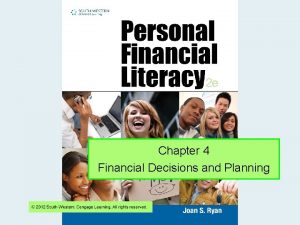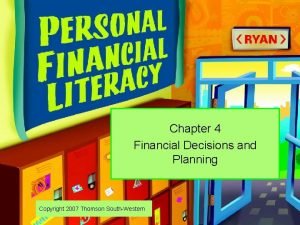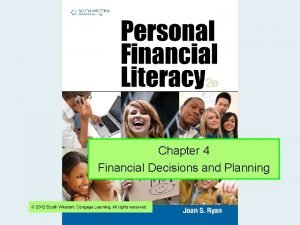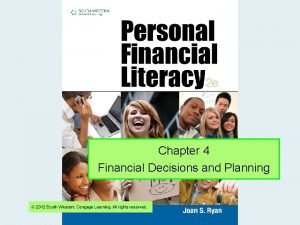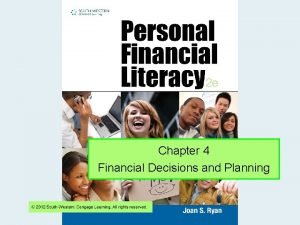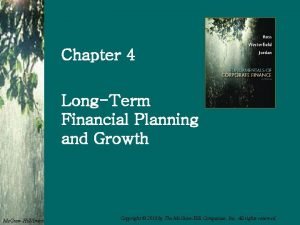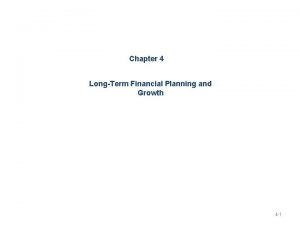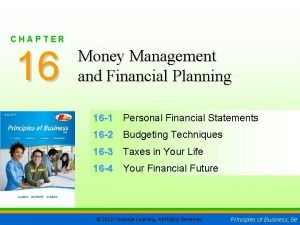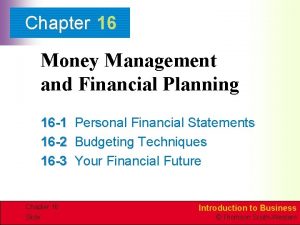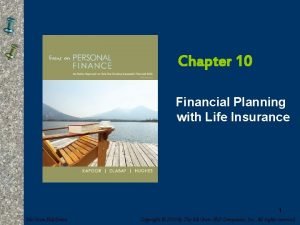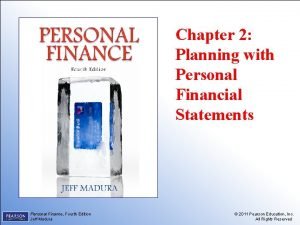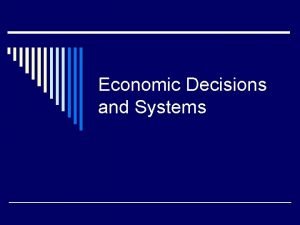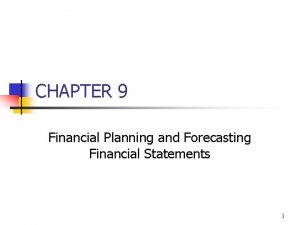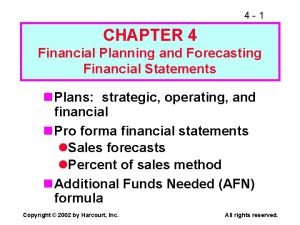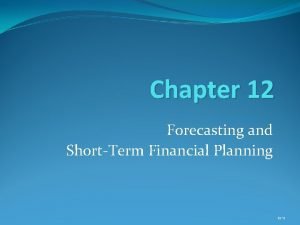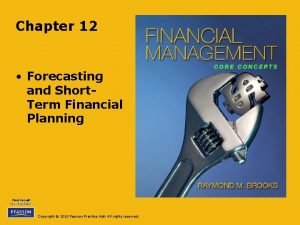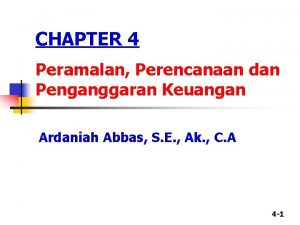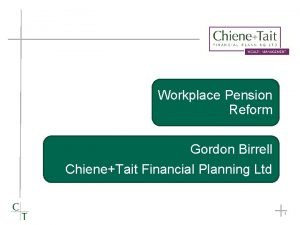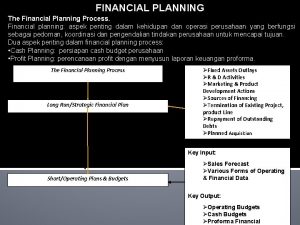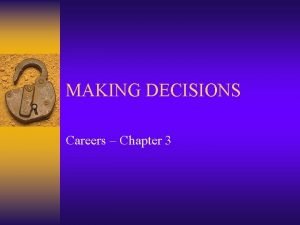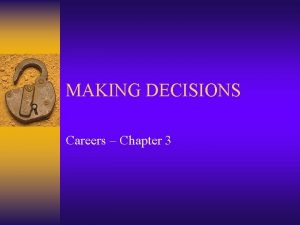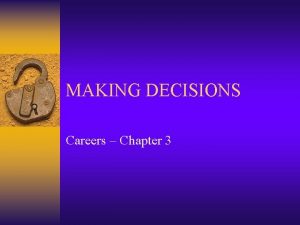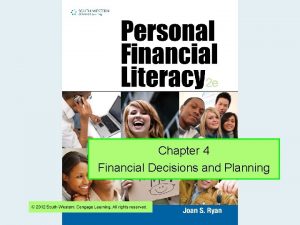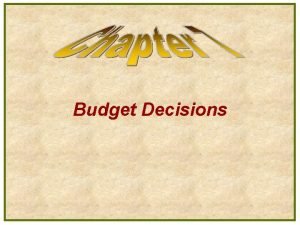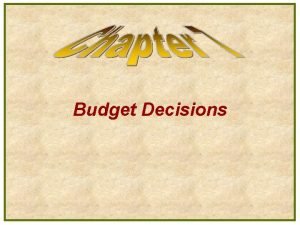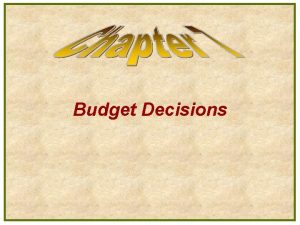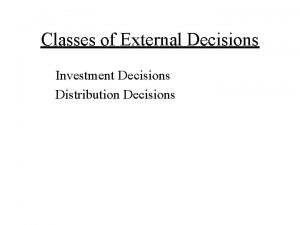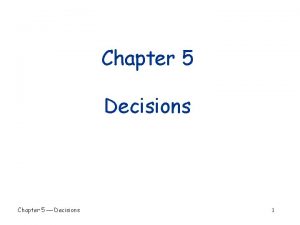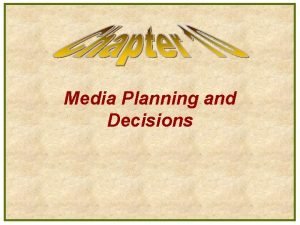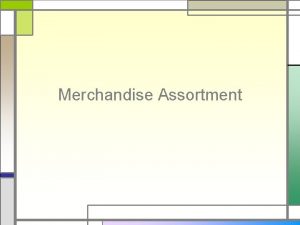Chapter 4 Financial Decisions and Planning What Are
























- Slides: 24

Chapter 4 Financial Decisions and Planning

What Are Needs and Wants? • Needs are things you must have. o Examples: food, clothing, shelter • Wants are things people desire. o Examples: new cars, vacations, luxury items • Financial resources are used to acquire goods and services. 4 -1 Resources and Choices Slide 2

What Are Needs and Wants? • Financial resources are used to acquire goods and services. • Include: money or other items of value • While financial resources are limited, wants and needs are unlimited and growing • You will have difficult decisions between wants and needs • The amount of money a person has to spend after needs are met is called discretionary income. 4 -1 Resources and Choices Slide 3

How Are Income and Wealth Measured? • • • Wealth: items of value minus any debts owed Personal cash flow statement lists cash inflows and outflows. o Inflows = income o Money received from your job, investments, other sources o Outflows = expenses o Net income = positive cash flow o Net loss = negative cash flow o SHOW CASH FLOW STATEMENT Personal net worth statement shows a person’s net worth based on assets and liabilities. o Assets = money or items of value o For assets like Cars, value is based on the price you could sell for. o Liabilities = debts o Amount owed for car is liability o Difference between assets and liabilities is net worth o Assets that grow in value are appreciating and assets that decline in value are depreciating 4 -1 Resources and Choices Slide 4

How Is Wealth Measured? PERSONAL NET WORTH STATEMENT Assets Cash and checking account Liabilities $ 452. 56 Car loan $1, 100. 00 Savings account 500. 00 Credit card debt 200. 98 Savings bond 300. 00 Total liabilities $1, 300. 98 Baseball card collection 100. 00 Computer, i. Pod, games 300. 00 Car, current value Total assets 3, 000. 00 $4, 652. 56 Net Worth Assets minus liabilities Total liabilities and net worth 3, 351. 58 $4, 652. 56 Net Worth 4 -1 Resources and Choices Slide 5

How Can You Make Good Financial Choices? Decision-Making Process • When you give up one option in exchange for another you make a trade off. • The trade off results in an opportunity cost, which is the value of the next best alternative • Value can be measured in dollars, time, convenience, enjoyment, and so forth • Give Ipod and bicycle example 1. Define the need. • What need or problem will be resolved from buying the item or service. • Computer for online research 2. List options for meeting the need. • Buy or borrow computer • Go to library 4 -1 Resources and Choices Slide 6

How Can You Make Good Financial Choices? 1. Compare the options. o List advantages and disadvantages o Consider the opportunity cost—the value of your next best option. o Opportunity costs of using library computer vs buying 2. Make a decision. 3. Take action based on your decision. 4. Reevaluate your choice. • Buyers remorse? • Make purchase that you later regret 4 -1 Resources and Choices Slide 7

What Is the Purpose of Budgeting? • A budget is a spending and saving plan. • Similar to cash flow statement because both record income and expenses. • However, a cash flow statement differs because it lists actual cash inflows and outflows to show much money you have available at a certain date. 4 -2 Basics of Budgeting Slide 8

What Is the Purpose of Budgeting? • Spreadsheet allows you to answer what if questions. • What if expenses go up 8%? • What is the price of the car you are saving for goes up 10%? • What if prices on utilities drop 5%? 4 -2 Basics of Budgeting Slide 9

How Do You Prepare a Budget? • Step 1: Estimate income • Keep track of money both earned and unearned. • Money should be calculated in weekly, monthly, and yearly • Once you see the big picture you're about to see how much comes in and goes out. It may change your spending habits. • Step 2: Plan savings • Pay yourself first, put money into savings before you consider other expenses. • Plan how much you want to save each month. This amount may have to change based on your expenses. 4 -2 Basics of Budgeting Slide 10

How Do You Prepare a Budget? • Step 3: Estimate expenses: expenses are items which you spend money. • Lunch, clothes etc. o Variable expenses: costs the go up and down every month o Gas or electric bill fluctuate with weather o Can vary due to changing prices o Food, clothing, and entertainment are all variable. o Fixed expenses: costs that do not change o Rent, insurance, car payments o Fixed expenses remain constant even when income does not. o If you lose you job, you may have to eliminate a fixed expense if you cannot afford it. An example would be a car. 4 -2 Basics of Budgeting Slide 11

How Do You Prepare a Budget? Charitable giving: act of donating money or time o Donate through the church o Donate money to red cross to help victims of natural disaster. • Step 4: Balance the budget • Savings and expenses should equal total income. • When these amounts are the same, the budget is balance o 4 -2 Basics of Budgeting Slide 12

Personal Budget Income Work (part-time) Allowance for household chores Lunch money allowance Savings account interest Total income Weekly Monthly Yearly $30. 00 15. 00. 50 $55. 50 $120. 00 40. 00 60. 00 2. 00 $222. 00 $1, 440. 00 480. 00 720. 00 24. 00 $2, 664. 00 $ 5. 50 $ 22. 00 $ 264. 00 Gifts Clothes and shoes Loan payment to parents Lunches Entertainment/miscellaneous Total expenses $ 5. 00 15. 00 10. 00 $50. 00 $ 20. 00 60. 00 40. 00 $200. 00 $ 240. 00 720. 00 480. 00 $2, 400. 00 Total savings and expenses $55. 50 $222. 00 $2, 664. 00 Savings Deposit to savings account Expenses 4 -2 Basics of Budgeting Slide 13

Budget Analysis • Variances – Favorable Variances – Unfavorable Variances – When you spend more than 10% of what you planned you should look at it carefully. Slide 14

Recordkeeping Methods • Manual records • Electronic records Slide 15

Focus On. . . Philanthropy • • Philanthropy is a form of charitable giving. It supports a societal cause. It often lasts for an extended period of time. It is the primary source of funding for the fine arts, performing arts, and most religious and humanitarian causes. 4 -2 Basics of Budgeting Slide 16

What Is Financial Planning? • Financial planning is a process of looking at your current financial situation and thinking about your future. • More than a budget. • Purpose is to plan for earning, saving, spending, and investing to allow you to achieve goals today and in the future. 4 -3 Personal Financial Planning Slide 17

What Is Financial Planning? • Step 1: Gather financial information – Everything related to your finances should be considered – List of financial records. Need to prepare first 3 • Cash flow statement, Net worth statement, Budget, Checkbook, Bank statements, Investment accounts, Insurance policies, Paycheck stubs, Tax returns, Wills, Trusts, Credit accounts, Any legal documents related to finances – At some point you will need to retire. – Look at medical history and medical history of family members to estimate life expectancy – You should plan to meet financial needs all the way to the end of life 4 -3 Personal Financial Planning Slide 18

What Is Financial Planning? • Step 2: Analyze information – Look at inflows and outflows – Answer questions • Is your income growing over time? • Is your net worth growing? • How are your spending habits changing? • Who else depends on your income? • What new goals do you need to add and plan? 4 -3 Personal Financial Planning Slide 19

What Is Financial Planning? • Step 3: Set goals o o o Personal goals: things you want to achieve in your life Financial goals: describe how you will pay for your personal goals. Short term goals: one week to one year o Replenish the money spent on PS 4 in savings account Medium term: 2 – 5 years o Save money for college o Increase income over the next 3 years Long term goals: 5+ years o Contribute to 401(k) for retirement o Buy a car 4 -3 Personal Financial Planning Slide 20

What Is Financial Planning? • • Step 4: Develop a timeline and benchmarks – Timeline: visual display of how long it will take to achieve each phase of your plan – Timeline should include benchmarks, which are standards progress is measured against. Step 5: Implement and evaluate the plan – Since goals and plans change, you need to constantly update your plan 4 -3 Personal Financial Planning Slide 21

Financial Plan (One Goal) FINANCIAL PLAN Net worth on April 1, 20 --: $525. 56 Personal Goal Financial Goal Benchmarks Timeline Live in my own house in the country. 1. Save money for a down payment ($12, 000) 5 years Buy a house in the country. • Set aside $200 per month Once per month • Open a separate account for money saved April 8 (next week) • Talk to a mortgage broker to get prepared Make an appointment for April 15 2. Get a job that provides enough income to make monthly payments 4 -3 Personal Financial Planning 2 years Slide 22

Where Can You Get Good Financial Advice? • Financial planners • Financial experts • Newspapers and magazines • Seminars and workshops • Financial websites 4 -3 Personal Financial Planning Slide 23

How Can You Protect Financial Resources? • • • Deal only with financial advisers you know and trust. Keep good records. Verify account balances regularly. Guard passwords. Be aware of phishing. – Internet scam in which an e-mail is sent from someone posing as your bank or other legitimate business asking for personal information. Guard against identity theft. 4 -3 Personal Financial Planning Slide 24
 Image making meaning
Image making meaning Mikael ferm
Mikael ferm Chapter 4 financial decisions and planning
Chapter 4 financial decisions and planning Chapter 4 financial decisions and planning
Chapter 4 financial decisions and planning Chapter 4 financial decisions and planning
Chapter 4 financial decisions and planning Chapter 4 financial decisions and planning
Chapter 4 financial decisions and planning Chapter 4 financial decisions and planning
Chapter 4 financial decisions and planning Screening decisions and preference decisions
Screening decisions and preference decisions Long term financial planning and growth chapter 4
Long term financial planning and growth chapter 4 Sustainable growth equation
Sustainable growth equation Chapter 16 money management and financial planning
Chapter 16 money management and financial planning What are some characteristics of a wise money manager
What are some characteristics of a wise money manager Chapter 10 financial planning with life insurance
Chapter 10 financial planning with life insurance Chapter 2 personal financial planning answers
Chapter 2 personal financial planning answers Chapter 10 personal loans and purchasing decisions
Chapter 10 personal loans and purchasing decisions Chapter 1 economic decisions and systems answer key
Chapter 1 economic decisions and systems answer key Non financial methods of motivation
Non financial methods of motivation Financial planning and forecasting
Financial planning and forecasting Financial planning and forecasting
Financial planning and forecasting Short term financial planning
Short term financial planning Financial planning and forecasting problems with solutions
Financial planning and forecasting problems with solutions Financial analysis planning and forecasting
Financial analysis planning and forecasting Planning budgeting forecasting
Planning budgeting forecasting Long term and short term financial planning
Long term and short term financial planning Least workplace
Least workplace


